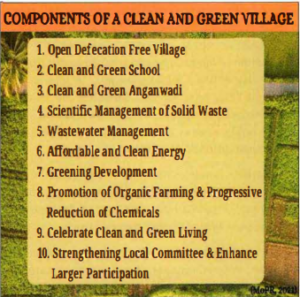Contents
- 1 Introduction
- 2 What is ‘Clean and Green’ Village and what are the agroecological approaches to develop ‘Clean and Green’ Villages ?
- 3 What are the various agro-ecological practices being followed in India for ‘Clean and Green’ Village?
- 4 What are the advantages of the use of agro-ecological practices for ‘Clean and Green’ Villages?
- 5 What are the Challenges in the adoption of these practices?
- 6 Conclusion
| For 7PM Editorial Archives click HERE → |
Introduction
Villages in an agrarian economy like India are the focus points for transforming the country’s developmental journey. ‘Clean and Green’ Villages are the key to rural development and the transformation to Vikshit Bharat by 2047. Promotion of agroecological practices in sectors, such as agriculture, energy, forestry can play a pivotal role in developing ‘Clean and Green’ Villages.
What is ‘Clean and Green’ Village and what are the agroecological approaches to develop ‘Clean and Green’ Villages ?
‘Clean and Green’ Village- The Clean and Green Village is the fifth among the nine themes adopted by the Ministry of Panchayati Raj to transform rural ecosystems with the support of the Gram Panchayat Development Plan (GPDP).
| Components of Clean and Green Village | |
| Clean | Green |
| 1.Access to safe & adequate drinking water and sanitation services. 2.Low pollution and emission levels. 3.Clean air and water that enables people to lead healthy and productive lives. | 1.Sustainable management of Village natural resources such as land and forests. 2.Ensuring food security while conserving the environment. |

Agro-ecological approach- Agro-ecological approach is an integrated approach that simultaneously applies ecological and social concepts, to the design and management of food and agricultural systems. It seeks to optimise the interactions between plants, animals, humans and environment.
What are the various agro-ecological practices being followed in India for ‘Clean and Green’ Village?
In India, the major agro-ecological practices and the schemes being followed are mentioned below-
1.’Organic and Natural Farming’ Practices for Clean and Green Villages
Organic and natural farming practice are based on agroecological principles and exclude the use of synthetic or chemical inputs. Organic and natural farming provides chemical and pesticide-free food grains and crops, improves soil health, and reduces environmental pollution.
Organic and natural farming contributes to ‘Clean and Green’ villages by helping in the conservation of natural resources, improving livelihoods, and providing safe and nutritious food.
Schemes and programmes for ‘organic and natural farming’
| Paramparagat Krishi Vikas Yojana (PKVY) | PMVY has been launched in 2015-16. It promotes organic farming through the creation of Cluster and Farmer Producer organisations. |
| Mission Organic Value Chain Development for North Eastern Region (MOVCDNER) | MOVCDNER is a Central Sector Scheme, a sub-mission under National Mission for Sustainable Agriculture (NMSA). It is being implemented in the states of Arunachal Pradesh, Assam, Manipur, Meghalaya, Mizoram, Nagaland, Sikkim and Tripura. |
| Bhartiya Prakratik Krishi Paddhati (BPKP) | BPKP launched in 2019-20 is a sub-scheme under PKVY. This scheme promotes natural farming in the country. |
| PM Programme for Restoration, Awareness Generation, Nourishment, and Amelioration of Mother-Earth (PM-PRANAM) | PM-PRANAM has been launched in 2003 by the Ministry of Chemicals and Fertilizers. This programme is initiated as a mass movement to save the health of Mother Earth by promoting sustainable and balanced use of fertilisers, adopting alternate fertilisers, promoting organic farming and implementing resource conservation technologies. |
2.’Waste to Wealth- Biogas and organic manure’ Practices for Clean and Green Villages
Biogas and organic manure are agroecological practices that convert agricultural, industrial, animal and municipal wastes into useful forms like energy and agricultural input.
Biogas and organic manure contribute to ‘Clean and Green Villages’ by reducing the greenhouse gas emissions, reducing pollution and improving waste management.
Schemes and Programmes for ‘Biogas and organic manure’
| The Galvanising Organic Bio-Agro Resources Dhan (GOBARdhan) | This scheme was launched in 2018 and is an integral component of Swachh Bharat Mission (Grameen). It ensures ‘Clean and Green’ villages by converting organic and biodegradable waste (cattle dung, kitchen leftovers, crop residue, market waste, etc.) into biogas and bio-slurry/bio-fertilizers. |
| National Biogas Programme | National Biogas Programme has been launched in 2022 by the Ministry of New and Renewable Energy (MNRE). It is to support the installation of biogas plants and their use as a source of alternative fuels for cooking purposes in the country. |
| Sustainable Alternative towards Affordable Transportation (SATAT) | SATAT initiative has been launched in 2018 by the Ministry of Petroleum and Natural Gas. It assures offtake of BioCNG or Compressed Biogas (CBG) after purification through Oil Marketing Companies (OMCs) for sale as automotive fuels. |
3.’Agro forestry’ Practices for Clean and Green Villages
Agro forestry is a cost-effective land management system that integrates crops, trees and/ livestock and provides economic and environmental benefits to small and marginal farmers.
Schemes and Programmes for Agro Forestry practices
| Sub-Mission on Agroforestry (Har Medh Par Ped) Scheme | It has been launched in 2016-17 to encourage tree plantation on farm land along with crops/ cropping system to help the farmers get additional income and make their farming systems more climate resilient and adaptive. |
| Mission for Integrated Development of Horticulture (MIDH) | It has been launched in 2014-15 for holistic growth of the horticulture sector covering fruits, vegetables, root and tuber crops, mushrooms, spices, flowers, aromatic plants, coconut, cashew, cocoa and bamboo. |
What are the advantages of the use of agro-ecological practices for ‘Clean and Green’ Villages?
Mentioned below are the advantages of the use of agro-ecological practices-
Economic transformation of Villages- The development of biogas sector, horticulture and organic farming increases the revenue sources of villages leading to their economic transformation.
Increased employment opportunities- The application of agro-ecological practices provides enhanced employment opportunities especially to rural women.
Mitigate effects of climate change- The application of agro-ecological practices increases ecological resilience with respect to volatile weather. It also increases carbon sequestration and water capture in soil.
Conservation of biodiversity and natural resources- Soil organic matter, water, crop genetic diversity and natural enemies of pests are conserved by the use of these practices.
Improvement of health and nutrition- There is reduction of incidence of pesticide poisonings and pesticide-related diseases due to adoption of organic farming.
What are the Challenges in the adoption of these practices?
Threats from powerful elites- Powerful lobbies (fossil fuel companies, fertilizer, seed companies & scientists with funding connections to agribusiness) perceive large-scale transitions to agroecology as a substantial threat to their influence on farming systems. They oppose organic farming and natural farming in India. Ex- National Academy of Agricultural Sciences, based on a brainstorming session that included industry representatives has sent a letter to the Prime Minister opposing Zero Budget Natural Farming (ZBNF).
Low awareness among the farmers- The major challenge with the adoption of these agro-ecological processes is the lack of awareness among the rural population.
Lack of financial resources- Lack of access to financial resources is a major hindrance in setting up of rural industries for creating value added products.
Effect on the food industry- The diversion of good agricultural land to plantation may decrease the crop production and can create scarcity of food.
Conclusion
Clean and Green Village objectives can be expedited by scaling up agroecology-based programmes and schemes. Their implementation at the grassroots level must be improved with support from panchayats, cooperatives, Self Help Groups (SHG), and women-SHGs.
| Read More- The New Indian Express UPSC Syllabus- Major crops and the cropping pattern in different regions/ parts of India |
Discover more from Free UPSC IAS Preparation Syllabus and Materials For Aspirants
Subscribe to get the latest posts sent to your email.







